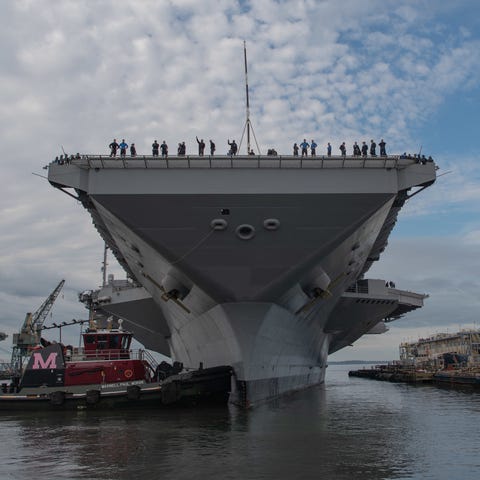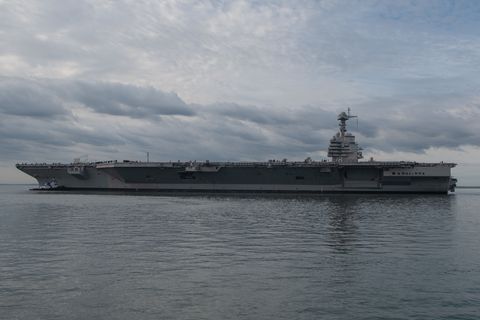
- The toilets on America’s two newest carriers clog frequently, causing problems throughout the ship.
- The ships use a scaled-up version of airliner toilets, using vacuum power to evacuate human waste.
- As a result, the system must regularly be cleaned with an expensive acid solution that costs $400,000 per use.
The toilets on America’s two newest aircraft carriers, USS Bush and USS Ford are experiencing clogging problems, and the only way to keep the pipes draining is to use a special, extremely expensive acid solution. The two carriers toilet plumbing system, modeled on the plumbing system installed on airliners, clog frequently requiring the Navy to regularly service them with an acid that costs $400,000 per use.
The problem, first reported by Bloomberg, is mentioned in a General Accountability Office (GAO) report on sustainment costs for Navy ships. The GAO report states that the Navy used a brand new toilet and sewage system for the USS George H.W. Bush and USS Gerald R. Ford, the last two aircraft carriers to roll off the production lines. The system is “similar to what is on commercial aircraft, but increased in scale for a crew of over 4,000 people.” GAO:
To address unexpected and frequent clogging of the system, the Navy has determined that it needs to acid flush the CVN 77 and 78’s sewage system on a regular basis, which is an unplanned maintenance action for the entire service life of the ship.
Each acid flush costs $400,000. The Navy, the GAO states, cannot predict how often this expensive procedure is necessary, making it difficult to predict how often it will need to repeat the procedure over the 50-year lifespans of each carrier.

The clogging problems with the new toilet system were well known even before USS Ford finished construction. In 2011, the Navy Times reported on toilet issues with the USS Bush, the first carrier to feature the toilet vacuum system, writing that during the ship’s maiden deployment in 2009, the ship averaged 25 calls a week to fix the commodes and all 432 commodes on the ship went down twice. The problem was reportedly so widespread sailors were peeing in bottles and emptying them overboard and experiencing health problems.
In response, the Navy claimed Bush had a 94 percent toilet availability, and that most problems were fixed in a few minutes. The Navy blamed the sailors flushing “inappropriate” materials down the toilets, including feminine hygiene products, food, and clothing. But the Navy also acknowledged that the system differed from the old system in that outages in one toilet affected a wider grouping of toilets than before.
The U.S. Navy plans to build up to 11 Ford-class carriers, gradually replacing existing Nimitz-class ships over the coming decades. The next ships in class are the USS John F. Kennedy, USS Enterprise, and USS Doris Miller. USS Ford cost a whopping $13 billion, more than twice as much as the USS Bush. USS Ford has experienced a number of technical issues, including getting the electromagnetic aircraft launch system working, the advanced arresting gear, a new radar system, and electromagnetically powered weapon elevators.
The GAO report also mentions a bigger problem with USS Ford than faulty toilets: the ship, designed to be less expensive to sail than previous classes, was projected to cost $77.3 billion over 50 years to operate, or $1.54 billion annually. Instead, the GAO projects the ship will cost $123 billion over the same period, or $2.46 billion a year. If the Navy builds all eleven ships the service will see a combined cost increase of $10 billion a year—the equivalent of four new destroyers with toilets that flush.
by Kyle Mizokami
http://www.thisoldtoilet.com


No comments:
Post a Comment